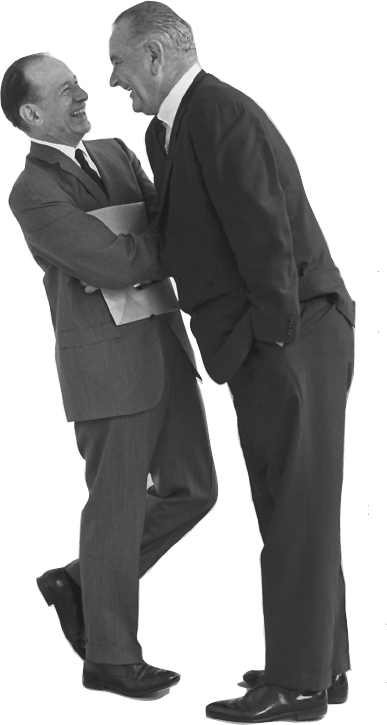Johnson Fulfills the Kennedy Promise
Printed Page 838

Lyndon B. Johnson assumed the presidency with a wealth of political experience. A self-made man from the Texas Hill Country, he had won election in 1937 to the House of Representatives and in 1948 to the Senate, where he served skillfully as Senate majority leader. His modest upbringing, his admiration for Franklin Roosevelt, and his ambition to outdo the New Deal president all spurred his commitment to reform. Equally compelling were external pressures generated by the black freedom struggle and the host of movements it helped inspire.
Lacking Kennedy’s sophistication, Johnson excelled behind the scenes, where he could entice, maneuver, or threaten legislators to support his objectives. The famous “Johnson treatment” became legendary. In his ability to achieve his legislative goals, Johnson had few peers in American history.
Johnson entreated Congress to act so that “John Fitzgerald Kennedy did not live or die in vain.” He signed Kennedy’s tax cut bill in February 1964. More remarkable was passage of the Civil Rights Act of 1964, which made discrimination in employment, education, and public accommodations illegal. The strongest such measure since reconstruction, the law required every ounce of Johnson’s political skill to pry sufficient votes from Republicans to balance the “nays” of southern Democrats. Senate Republican leader Everett Dirksen’s aide reported that Johnson “never left him alone for thirty minutes.”
 Law that responded to demands of the civil rights movement by making discrimination in employment, education, and public accommodations illegal. It was the strongest such measure since Reconstruction and included a ban on sex discrimination in employment.
Law that responded to demands of the civil rights movement by making discrimination in employment, education, and public accommodations illegal. It was the strongest such measure since Reconstruction and included a ban on sex discrimination in employment.
CHAPTER LOCATOR
What liberal reforms were advanced during the Kennedy and Johnson administrations?
How did the civil rights movement evolve in the 1960s?
What other rights movements emerged in the 1960s?
What were the goals of the new wave of feminism?
How did liberalism fare under President Nixon?
Conclusion: What were the achievements and limitations of liberalism?
 LearningCurve
LearningCurve
Check what you know.
Antipoverty legislation followed fast on the heels of the Civil Rights Act. Johnson announced “an unconditional war on poverty” in his January 1964 State of the Union message, and in August Congress passed the Economic Opportunity Act. The law authorized ten new programs, allocating $800 million — about 1 percent of the federal budget — for the first year.
The most novel and controversial part of the law, the Community Action Program (CAP), required “maximum feasible participation” of the poor themselves in antipoverty projects. Poor people began to organize to take control of their neighborhoods and to make welfare agencies, school boards, police departments, and housing authorities more accountable to the people they served. Even though Johnson backed off from pushing genuine representation for the poor, CAP gave people usually excluded from government an opportunity to act on their own behalf and develop leadership skills.
Programs of the Economic Opportunity Act
> Programs of the Economic Opportunity Act
- Head Start for preschoolers
- Work-study grants for college students
- Job Corps for unemployed young people
- Volunteers in Service to America (VISTA) to work with the disadvantaged
- Legal services for the poor
- Community Action Program requiring participation by the poor in antipoverty projects